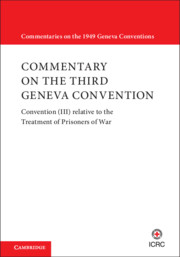 Commentary on the Third Geneva Convention
Commentary on the Third Geneva Convention Book contents
- Commentary on the Third Geneva Convention
- International Committee of the Red Cross
- Copyright page
- Contents
- Foreword by Peter Maurer
- Acknowledgements
- Abbreviations
- Introduction
- Preamble
- Part I General Provisions
- Part II General Protection of Prisoners of War
- Part III Captivity
- Section I Beginning of captivity
- Article 17 Questioning of Prisoners
- Article 18 Property of Prisoners
- Article 19 Evacuation of Prisoners
- Article 20 Conditions of Evacuation of Prisoners
- Section II Internment of prisoners of war
- Section III Labour of prisoners of war
- Section IV Financial resources of prisoners of war
- Section V Relations of prisoners of war with the exterior
- Section VI Relations between prisoners of war and the authorities
- Part IV Termination of Captivity
- Part V Information Bureaux and Relief Societies for Prisoners of War
- Part VI Execution of the Convention
- Book part
- Sources
- Index
- References
Article 20 - Conditions of Evacuation of Prisoners
from Section I - Beginning of captivity
Published online by Cambridge University Press: 21 August 2021
- Commentary on the Third Geneva Convention
- International Committee of the Red Cross
- Copyright page
- Contents
- Foreword by Peter Maurer
- Acknowledgements
- Abbreviations
- Introduction
- Preamble
- Part I General Provisions
- Part II General Protection of Prisoners of War
- Part III Captivity
- Section I Beginning of captivity
- Article 17 Questioning of Prisoners
- Article 18 Property of Prisoners
- Article 19 Evacuation of Prisoners
- Article 20 Conditions of Evacuation of Prisoners
- Section II Internment of prisoners of war
- Section III Labour of prisoners of war
- Section IV Financial resources of prisoners of war
- Section V Relations of prisoners of war with the exterior
- Section VI Relations between prisoners of war and the authorities
- Part IV Termination of Captivity
- Part V Information Bureaux and Relief Societies for Prisoners of War
- Part VI Execution of the Convention
- Book part
- Sources
- Index
- References
Summary
Article 20 outlines the conditions in which the evacuation of prisoners ofwar from the combat zone to safe camps must be carried out. It supplementsArticle 19, which requires such evacuation to take place as soon as possibleafter the prisoners have fallen into the power of the enemy.
- Type
- Chapter
- Information
- Commentary on the Third Geneva ConventionConvention (III) relative to the Treatment of Prisoners of War, pp. 686Publisher: Cambridge University PressPrint publication year: 2021
